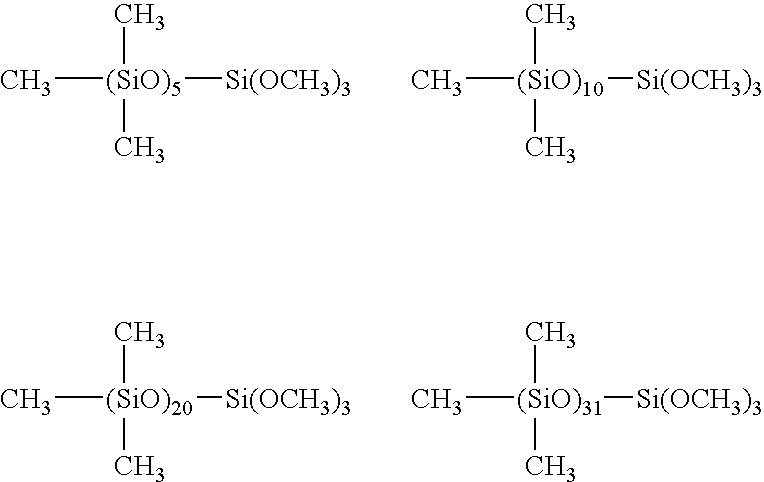Heat-conductive silicone composition
a technology of silicone and composition, applied in the direction of heat-exchange elements, chemical instruments and processes, etc., can solve the problems of increasing the heat generation of electronic parts during operation, easy handling and manipulation of low-hardness heat-conductive sheets, and reducing the viscosity of the product. , to achieve the effect of preventing contamination of the surrounding environment, high mass production efficiency, and reducing the viscosity
- Summary
- Abstract
- Description
- Claims
- Application Information
AI Technical Summary
Benefits of technology
Problems solved by technology
Method used
Image
Examples
example
[0072]Examples of the invention are given below by way of illustration, but not by way of limitation.
[0073]First, the following components were provided before compositions were prepared therefrom.
Component A
[0074]A-1: D25TΦ55DVi20 (weight average molecular weight 3300 versus polystyrene standards, softening point 40-50° C.) Herein D is a dimethylsiloxane unit ((CH3)2SiO),[0075]TΦ is a phenylsiloxane unit ((C6H5) SiO3 / 2), and [[DVi]][0076]DVi is a methylvinylsiloxane unit ((CH3) (CH2═CH) SiO).[0077]A-2: organopolysiloxane of the following compositional formula.
Component B
[0078]B-1: aluminum powder (average particle size: 25.1 μm) theoretical specific gravity 2.70[0079]B-2: aluminum powder (average particle size: 1.6 μm) theoretical specific gravity 2.70[0080]B-3: zinc oxide powder (average particle size: 0.7 μm) theoretical specific gravity 5.67[0081]B-4: aluminum oxide powder (average particle size: 10.1 μm) theoretical specific gravity 3.98
Component C
[0082]C-1: Isozole® 400 (isopa...
PUM
| Property | Measurement | Unit |
|---|---|---|
| viscosity | aaaaa | aaaaa |
| viscosity | aaaaa | aaaaa |
| viscosity | aaaaa | aaaaa |
Abstract
Description
Claims
Application Information
 Login to View More
Login to View More - R&D
- Intellectual Property
- Life Sciences
- Materials
- Tech Scout
- Unparalleled Data Quality
- Higher Quality Content
- 60% Fewer Hallucinations
Browse by: Latest US Patents, China's latest patents, Technical Efficacy Thesaurus, Application Domain, Technology Topic, Popular Technical Reports.
© 2025 PatSnap. All rights reserved.Legal|Privacy policy|Modern Slavery Act Transparency Statement|Sitemap|About US| Contact US: help@patsnap.com



